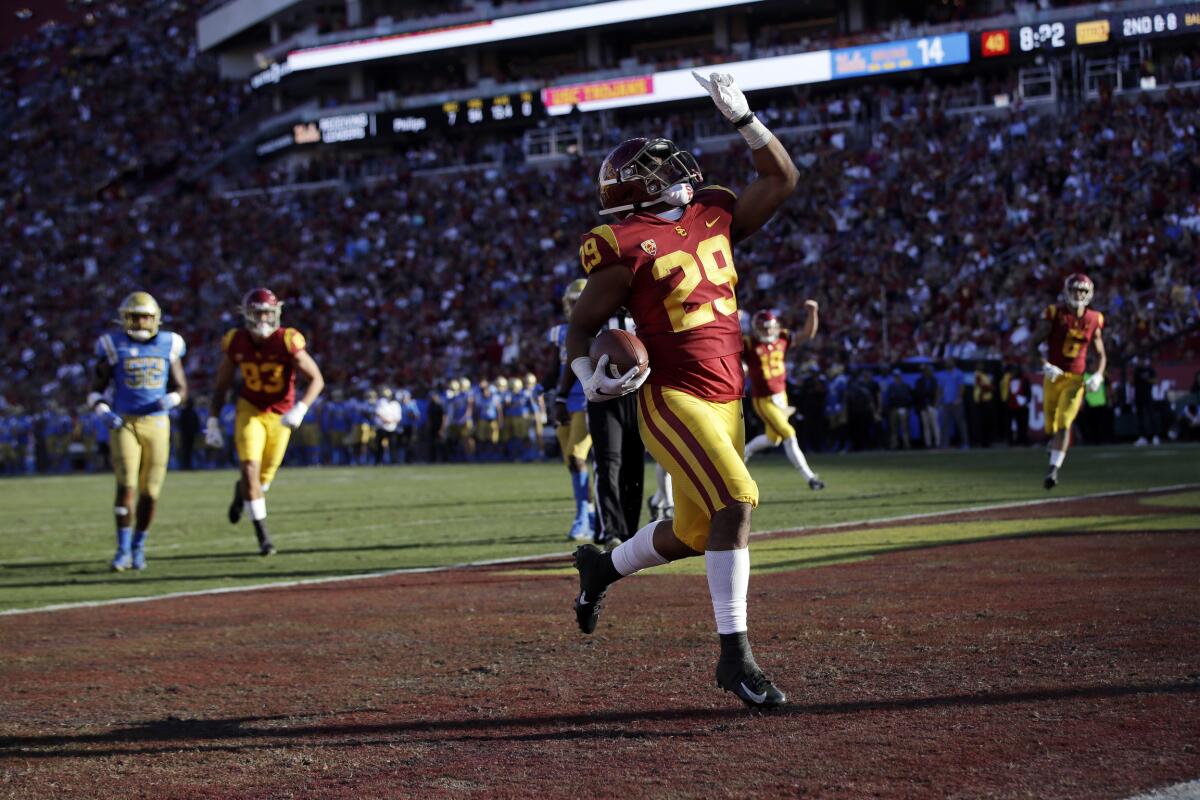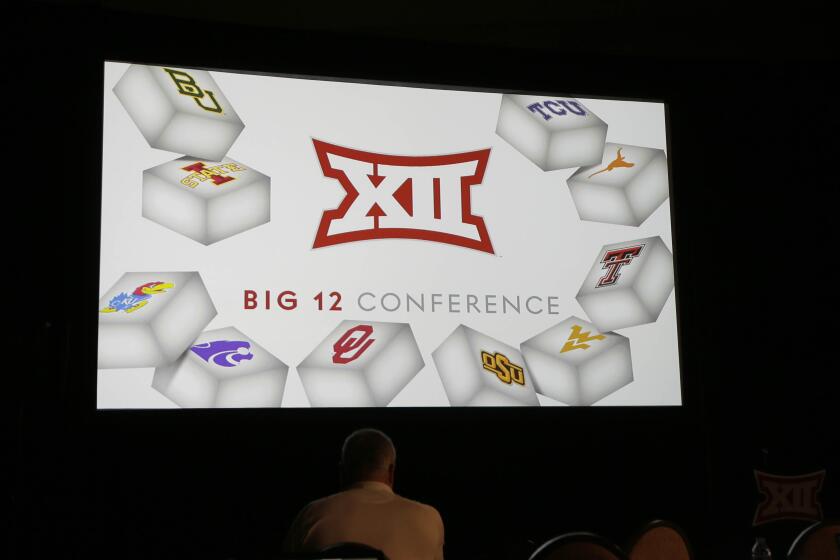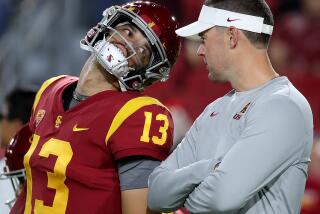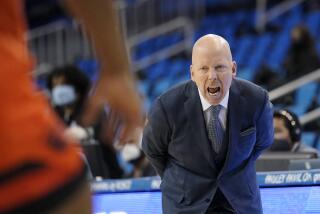College football in the spring presents its own set of coronavirus and scheduling problems

- Share via
Months ago, when a fall consumed by COVID-19 felt unimaginable and a canceled college football season seemed only an unthinkable, apocalyptic concept, a parade of college administrators from across the country tripped over one another to toss cold water on the possibility of playing football in the spring.
The idea was tossed around briefly in April, shortly after college sports were canceled the first time. But the logistics were too demanding, the undertaking too great for decision-makers to deem it any more than a “last resort.” A spring backup plan was quickly tossed aside, in favor of crossed fingers for fall.
But a hope and a prayer weren’t enough to hold the football season together while the country remains firmly in the grip of a global pandemic. At least not in the Pac-12 or Big Ten. Both conferences, each pillars of the Power Five, officially canceled their fall football seasons Tuesday, training their focus instead on regrouping for spring, when, in the face of potential nine-figure financial ruin, even a last resort could sound quite appealing.
Whether it’s possible is another question entirely. There’s no guarantee there will be a COVID-19 vaccine by the new year — or that the pandemic will even be under better control. Even in the most hopeful scenarios for the virus, the challenges in pulling off a season in the spring are significant. There’s a reason why the Atlantic Coast, Southeastern, and Big 12 conference aren’t sold on stalling until spring.
Mike Bohn, USC’s athletic director, described the job at hand as “Herculean” — and that was only when asked about scheduling on his own campus.
UCLA coach Mick Cronin and USC coach Andy Enfield have tossed around ideas on what the 2020-2021 college basketball season could look like including a bubble concept and May Madness tournament.
Pessimism abounds. Even off-shore oddsmakers are skeptical — BetOnline gives the league slightly worse than 4-1 odds of kicking off at all.
Plenty can change between now and Jan. 1, but as administrators, coaches, and players place their faith in spring football, the reality is they’re trading safety concerns now for others later, all the while creating a tangled web of logistics that will need to be addressed before an unprecedented season is even possible.
“The things that are going to come up are: Where are we in the world?” USC coach Clay Helton said. “Where are we with the infection rate? Where are we with testing? Where are we with the study of the heart and the damage this virus has done to it?”
And those are just questions mostly pertaining to the virus. While college football has largely become a year-round undertaking, with spring practice and summer workouts tucked between campaigns, the prospect of playing two seasons in one calendar year is a particularly unsettling part of any spring equation. For health and scheduling reasons.
How many games would be played? When would they begin? And could a college football player really handle two dozen games in 2021, with just a few months of break in the middle?
Pac-12 Commissioner Larry Scott floated the possibility of a “compressed season” on Tuesday. But while medical advisors were behind the conferences’ decisions to cancel, it’s still unclear how most feel about the physical impact any semblance of a spring season might have on players who are expected to be ready for another season in the fall.
“As an orthopedic surgeon, it gives me a little bit of pause to play two seasons in a calendar year,” said Dr. Seth Gamradt, who works at USC and is a member of the Pac-12 medical advisory board. “But that doesn’t mean that it can’t be done.”
If it does go forward, it’s likely that the 2021 season would need to be pushed back — a decision that, in turn, would likely create further ripple effects on the college calendar.
“I don’t know if we would get back to a regular September football start date for three to four years,” UCLA linebacker Bo Calvert mused. “You would have to incrementally push back the date, so if we started in January this year and go to the end of May, maybe at the earliest the season starts the next year late November or December and the next year you try to bump it back up.”
A January start might not sound so bad in Southern California, but it could be a legitimate concern in Ann Arbor, Mich., or Minneapolis, Minn.
“Being a native of the Northeast, I’m glad I live in California if they say we’re going to play in January,” UCLA coach Chip Kelly said.
Whenever a spring season were to kick off, it would probably be without many of the sport’s top prospects. The NFL has yet to offer any indication that it’s willing to postpone the draft, but with a start date currently slated for April 29 and offseason training activities scheduled soon after, the expectation is that many top college players will opt out to save themselves for the NFL. Several, such as Penn State linebacker Micah Parsons and Miami edge rusher Greg Rousseau, already have.
How many will actually sit when all is said and done is still to be determined. Marc Ross, the former vice president of player personnel for the New York Giants and a current NFL Network analyst, said he expected only the “very top, top players” to skip their final college seasons to prepare for the pros.
“I think the majority of players will still feel like they have something to prove,” Ross said.
USC has at least four players on the edge of that category — all of whom are potential top-100 players, but none of which are surefire first-rounders. Alijah Vera-Tucker said last week that he would have to have that conversation with his family and coaches. Safety Talanoa Hufanga echoed the same message on Wednesday, saying he preferred to live in the moment.
The Big 12 Conference announces its decision to forge ahead with a fall sports season, a day after the Pac-12 and Big Ten pulled the plug.
In a team meeting the night before, Helton advised his players to take their time and not make “an emotional decision” on the draft.
“Garner all information,” he said. “See where we are as a whole in college football, see where we are in an NFL calendar, whether we have a spring season or not.”
Then, there’s the most unpredictable variable of all. In addressing the Pac-12’s decision to cancel the season, Scott confidently declared that “we know the situation [with the virus] is going to improve,” but every shred of optimism comes with a series of caveats.
Some epidemiologists warn that flu season in the winter could cause an uptick in cases. Asked about the possibility of a spring season, Big 12 Commissioner Bob Bowlsby wondered Wednesday whether starting in January wouldn’t just leave players “in the teeth of the virus.”
The Pac-12 is banking on advancements in point-of-care testing, as well as further data on cardiac impacts of young COVID-19 patients, to ensure that doesn’t happen. But without some control over the virus, those hopes and prayers are unlikely to be answered.
Pushing the college football season to spring won’t suddenly solve that problem. In fact, it’s certain to create more logistical headaches.
But in a landscape where every other option has already slipped away, the last resort is all that’s left.
Times staff writer Ben Bolch contributed to this report.
More to Read
Go beyond the scoreboard
Get the latest on L.A.'s teams in the daily Sports Report newsletter.
You may occasionally receive promotional content from the Los Angeles Times.









